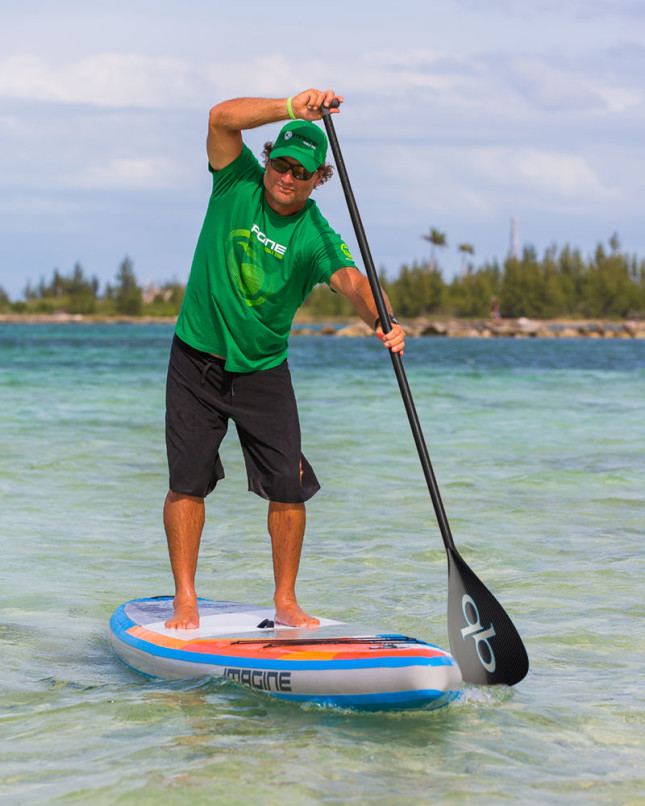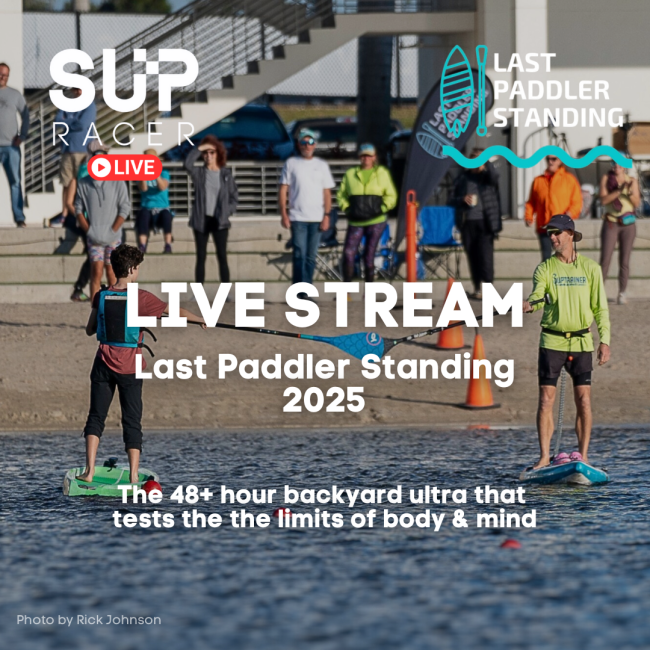
Dave Kalama’s Bold Proposal For The Future Of SUP Racing

Boss Man’s note: Dave Kalama is one of the visionary pioneers of this great sport. He’s been around since the early days and is always playing around with new ideas and concepts, recently creating a one of the most innovative new paddles on the market.
Well now Dave has turned his sights to the world of stand up paddle race boards (and racing) in general. The big guy has a very unique and interesting idea that would radically alter the SUP racing landscape, but which could also solve a few fundamental problems the sport faces.
Have a read through Dave’s guest post and then leave a comment at the bottom – we’d love to hear your thoughts on this one.
A Race Should Just Be A Race: How To Improve SUP Racing By Making Race Boards More Open, More Convenient And More Fair – by Dave Kalama
The current SUP race board landscape is a rather confusing thing. I feel we have too many board classes, too many race divisions and too many issues traveling with our equipment. I believe it’s making our sport less accessible, less fair and less fun.
However I also believe there’s one simple solution that solves all of these issues. Bare with me on this one – it’ll probably seem a little shocking at first but I think it could make the sport a lot more successful in the long run.
So today we have two dominant board classes in SUP racing: 12’6 and 14.
The basis for these length restrictions, at least the 12’6, began with the 2008 Battle of the Paddle and was related to the longest polyester foam blank available at the time. However in the past six years styrofoam technology has improved to a point that we can now get high quality foam blanks in any length we want.
The very basis for the 12’6 has become irrelevant, yet it’s still the dominant race board worldwide. This is despite the disadvantage it imposes on larger guys and despite the fact it’s the slowest board class out there.
There’s been a lot of recent debate about introducing board restrictions, however we’ve actually had restrictions since day one. And they’ve been the most limiting of all restrictions: The restriction on length. It almost feels like we’re ‘stuck’ with the 12’6. I think most paddlers will admit 12’6 was a convenient but totally arbitrary number invented without too much thought for the future of the sport.
So why haven’t we evolved? Why do we still obsess over the 12’6 when there are better options?
There are a few reasons, but the main one seems to be the travel factor. 12’6 boards are obviously easier to transport, whether it’s manufacturers shipping to retailers, athletes traveling on planes or even just finding room for them in your garage. Shorter is easier.
I know several events that chose the 12’6 as the main board class, not because it suited the conditions or added to the dynamics of the race, but purely because it minimized logistical issues.
Well then *if* transportation and logistics are such a big issue, why aren’t we all just racing inflatables?
What if we all raced on inflatable race boards that had no restrictions on length but were still easy to transport? Racing on inflatables would totally remove the need for these controversial length restrictions, because transportability is no longer an issue.
So I say let’s all race inflatables and let’s make them any length we want.
No more 12’6 vs 14 vs unlimited arguments. They’re just inflatable race boards, period. There would no longer be such a thing as board classes at all, you’d just choose whichever length you think will go fastest on the day.
I know it’s a mildly shocking concept and may take a while to sink in, but I believe it would solve some major issues and make SUP racing more open and accessible. There are three main reasons:
The first is making it easier and cheaper to transport. That one’s obvious.
The second is that unrestricted inflatables would allow us to find the optimum board design. The current length restrictions (12’6 and 14′) are arbitrary numbers and I’m sure most paddlers would agree they’re not necessarily the best sizes.
The third reason is perhaps the most significant: Moving to inflatable race boards erases the argument about board classes. With unrestricted inflatable racing, there are no board classes. It’s just a race. Turn on up whatever you like. First over the line wins. Simple.
No messy fragmentation with several different board classes. Let’s just focus on the race itself.
The current racing scene, where events have several races within a race due to so many different board classes, is confusing even to regular paddlers, let alone those on the fringe of the sport who we’re trying to draw in.
I’d hope that most paddlers would agree: A race should be a race, not an argument over board classes or a debate about ease of travel.
I also believe most paddlers who’ve tested extensively would concur that inflatables aren’t far behind carbon boards in terms of speed. In sub-planing race conditions, the round rails of an inflatable aren’t much of a disadvantage at all. We’re talking just a couple percentage points slower in my experience.
Another positive is that construction limitations for inflatables would move us slightly closer to one design racing, where the onus is more on the paddler’s performance and not so much the board. No more arguments or asterisks in the results (“Yeah but he was paddling the new 2015 flat water model…”).
If transportability and convenience are the main reasons for keeping our existing, arbitrary board length restrictions, then why don’t we just switch to inflatables?
With inflatables, transportability and convenience are non issues.
With inflatables you can go as long or short as you want. There are no restrictions. If it rolls up and fits in a bag, you can take it on a plane.
The smaller guys might have an advantage on a shorter board while the larger guys would probably go for longer boards. Suddenly the length is proportionate to the weight and expertise of the paddler.
Kai Lenny might show up at Maliko on a 14’6, whereas I might take an 18 footer. And those boards might be the fastest for our respective weight and style of paddling. Kai might go faster on his 14’6 than he does on my 18 footer (and vice versa).
Switch to the Battle of the Paddle at Salt Creek, where perhaps we score solid 4-5 ft surf and it turns out the optimum length is 11’6.
We’d simply choose the best board for the day.
Larger guys might have a slight advantage in some conditions, smaller guys might have the advantage in other types of racing. That’s just the same way that different body shapes suit different styles of racing in running, cycling and other forms of racing.
But either way, each paddler would have the freedom to paddle whatever sized board suits them best – the whole point of inflatable racing would be to erase any limits.
If we moved to inflatables, there would be no more board classes. It’s just a race. Board classes become irrelevant. In ten years, when paddlers are racing whatever length they want, we’d look back and laugh at how we used to argue about 12’6 vs 14.
I realize this concept will take some adjusting to. Board classes are so ingrained in racers’ minds that the very idea of having “no classes” must seem quite foreign. But I believe it’ll make the sport a lot more open, accessible and successful in the long run.
And to those who say inflatables are too slow and heavy: Imagine how quickly the technology will advance if we focus on inflatables at the elite end of the sport. In 2-3 years we’ll be paddling inflatables that make today’s models look like children’s toys. We’ll eventually get to a point where the difference between carbon and inflatable becomes negligible.
But either way the argument is moot right now: Even if inflatables are 5% or 10% slower today, if we’re all racing on them, we’ll all be in the same boat. i.e. we’ll all be 5-10% slower so it would still be fair. It’s the same as saying we shouldn’t complain about racing 12’6 boards instead of 14 footers, because we’ve all got the same handicap.
And I totally agree. Though let’s take it a step further and remove restrictions altogether…
Manufacturers will be happy: You can fit a hell of a lot more inflatables in a shipping container, which speeds up distribution, increases industry margins and makes the boards cheaper for consumers.
Paddlers would enjoy the ease of travel and the freedom to choose their own board length.
Even racer organizers would benefit: No more messy scenarios where there are four different races within a race. No more complicated registration and results. No angry emails from some dude that got listed under the wrong class in the results. The paddlers just show up to an event, enter the race and wherever they finish, that’s their placing.
No more board classes. The race is just a race. Simple.
And as a huge bonus: If you want to fly to that race with your equipment, no problem at all.
No restrictions, no board classes, no travel headaches, no BS.
As an unlimited downwind racer myself, my mind’s not stuck on a certain board length. I don’t design a board with any set length in mind. I’ll play around with 15, 16, 17 or 18 foot protoypes and see which works best for me. Whereas most designers and shapers have extreme limitations before they’ve even begun, because their board has to be a very specific length.
I believe unrestricted inflatable racing would eventually have a Darwin Effect: Without limitations, the length of race boards will be determined by thorough testing and analysis, rather than someone else’s preconceived idea about board sizes. We’d eventually find optimum lengths for different sizes of paddlers and different types of race conditions.
It all comes back to two things: Paddle the fastest board you can and make a race just a race.
I think it’ll make the sport of SUP racing more open, accessible and successful.
What do you think?
Questions? Comments? Criticism? Leave a comment below – I’d love to hear your take on this.





You must be logged in to post a comment.